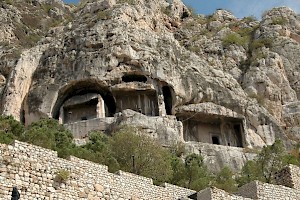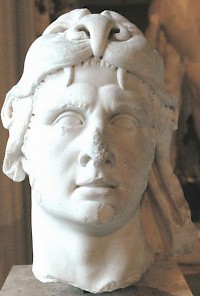Pontus (kingdom)
Q7380487Pontus: Hellenistic kingdom in Anatolia.

Originally, "Pontus" was the name of the northern part of what is now called Turkey, stretching from the delta of the river Halys to the east. It also included the mountain range that is still called the Pontic Alps. When the Greek mercenary Xenophon passed through this area, he found it inhabited by the Chalybes, Macroni, and Tibereni. They had been living under Persian sovereignty for more than a century, belonged to the satrapy of Cappadocia, and were partly Iranized.
There were several Greek cities on the coast, like Trapezus, which continued to receive new settlers. For example, there was an influx of colonists in 368/367, when people from Arcadian Trapezus migrated to Pontic Trapezus.note So, Pontus offered a mix of Iranized Anatolian tribes and Greek settlers.
 Pontic Alps near Gümüşhane |
 Pontic Alps: the Iris River |
 Pontic Alps near Ispir |
 Pontic Alps near Trabzon |
The Mithridatic dynasty, which had its roots in the northwest of Persian Anatolia, seized power in the confused age after the conquests of Alexander the Great, who had never conquered this part of Anatolia.
| Mithridates I Ktistes |
|
| Ariobarzanes |
|
| Mithridates II |
|
| Mithridates III |
|
| Pharnaces I |
|
| Mithridates IV Philopator |
|
| Mithridates V Euergetes |
|
| Mithridates VI Eupator |
|
| Pharnaces II |
|
| Darius and Arsaces |
|
Mithridates I was the first to call himself king and would be nicknamed Ktistes, "founder". His base was Paphlagonia, a bit to the west of Pontus, but his descendants continued to add Greek ports and regions in the interior, losing control of Paphlagonia at some point. Pontus could slowly expand because Anatolia had been alloted to the Seleucids, who never gained full control of this part of the former Achaemenid Empire. Instead, the Seleucids preferred a marriage alliance with the Mithridatic kings.

The Mithridatic rulers also allied themselves to the Galatians, who had invaded Anatolia. Later, they would find a powerful ally in Rome (which had initially supported Cappadocia against Pontus) and king Mithridates V Euergetes (r.151/150-120) was able to add Paphlagonia. This was an important addition and he moved his residence from Amasia to the former Paphlagonian city of Sinope. During his reign, the Seleucid Empire started its protracted decline and Pontus was now one of the most powerful states in Anatolia.
Mithridates V was succeeded by Mithridates VI Eupator, who was able to conquer Colchis (more or less modern Georgia) and the Bosporan Kingdom (the Crimea) and expand his kingdom along the eastern and northern shores of the Black Sea. He also gained control in smaller kingdoms in post-Seleucid Anatolia (Galatia, Cappadocia) and allied himself to Bithynia and Armenia. Having expanded his power base, he embarked upon an anti-Roman policy. Between 90 and 65, he waged three wars against Rome, eventually losing his kingdom and his life. From now on, Rome was the new master of Anatolia.

This was not the end, however. While the Romans were fighting their Second Civil War, between Julius Caesar and Pompey the Great, Mithridates' son Pharnaces attempted to rebuild Pontic power. He had been too optimistic about his chances. Caesar, who had defeated Pompey, immediately marched to Anatolia, joined forces with king Deiotares of Galatia, and defeated Pharnaces at Zela.
The western part of Pontus was added as an annexe to the Roman province of Bithynia. There were three kings left, belonging to a different dynasty, and ruling in the eastern part of the former kingdom.
| Polemon I Eusebes |
|
| Pythodoris |
|
| Julius Polemon II |
|
After this, Pontus became part of the province of Bithynia, which was from now on called Bithynia et Pontus.